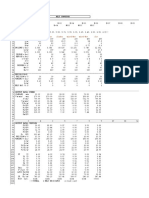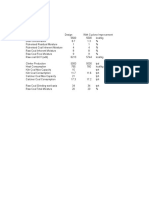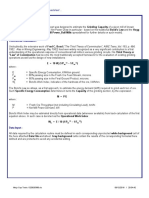Fuersteneau Power Model (See Mill Power - Ball Mills Spreadsheet For Further Details On Such Model)
Fuersteneau Power Model (See Mill Power - Ball Mills Spreadsheet For Further Details On Such Model)
Uploaded by
Christofer EspinozaCopyright:
Available Formats
Fuersteneau Power Model (See Mill Power - Ball Mills Spreadsheet For Further Details On Such Model)
Fuersteneau Power Model (See Mill Power - Ball Mills Spreadsheet For Further Details On Such Model)
Uploaded by
Christofer EspinozaOriginal Description:
Original Title
Copyright
Available Formats
Share this document
Did you find this document useful?
Is this content inappropriate?
Copyright:
Available Formats
Fuersteneau Power Model (See Mill Power - Ball Mills Spreadsheet For Further Details On Such Model)
Fuersteneau Power Model (See Mill Power - Ball Mills Spreadsheet For Further Details On Such Model)
Uploaded by
Christofer EspinozaCopyright:
Available Formats
About the Bond_Op. Work Index Spreadsheet ...
Scope :
The Bond_Op. Work Index spreadsheet was designed to estimate the Operational Work Index of a given grinding
installation of known dimensions and operating conditions, based on the traditional Bond's Law and the Hogg &
Fuersteneau Power Model (see Mill Power_Ball Mills spreadsheet for further details on such model).
Theoretical Framework :
Undoubtedly, the extensive work of Fred C. Bond ("The Third Theory of Comminution", AIME Trans.,Vol. 193, p. 484,
1952. Also in Mining Engineering, May 1952) has been widely recognized as a very significant contribution to a first
understanding of the operational response of conventional ball mills in various grinding circuits. His Third Theory or
"Law" of Comminution has become the most traditionally accepted framework for the evaluation of existing grinding
operations as well as the design of new installations :
E = 10 Wi (1/P801/2 1/F801/2)
where :
E
F80
P80
Wi
=
=
=
=
Specific Energy Consumption, kWh/ton ground.
80% passing size in the Fresh Ore Feed Stream, microns.
80% passing size in the Final Ground Product, microns.
Bond's Work Index, indicative of the hardness of the ore, kWh/ton.
The Bond's Law so allows, as a first approach, to estimate the energy demand (kWh) required to grind each ton of ore.
Such Specific Energy Consumption determines in turns the Capacity of the grinding section, by the expression :
M = P/E
where :
M
P
= Fresh Ore Throughput (not including Circulating Load), ton/hr.
= Net Mill Power Demand, kW.
Bond's Work Index may be estimated directly from operational data (whenever available) from back-calculation of the first
equation above. In such case is denoted as the Operational Work Index :
Wio = E / 10 (1/P801/2 1/F801/2)
Data Input :
All data required by the calculation routine must be defined in each corresponding unprotected Turquesa background cell
of the here attached Data File worksheet. blue background cells contain the results of the corresponding formulas there
defined and are protected to avoid any accidental editing.
Moly-Cop Tools / 293623080.xls
11/04/2015 / 19:20:09
Moly-Cop Tools / 293623080.xls
11/04/2015 / 19:20:09
to estimate the Operational Work Index of a given grinding
ns, based on the traditional Bond's Law and the Hogg &
spreadsheet for further details on such model).
Third Theory of Comminution", AIME Trans.,Vol. 193, p. 484,
widely recognized as a very significant contribution to a first
nal ball mills in various grinding circuits. His Third Theory or
ally accepted framework for the evaluation of existing grinding
1/F801/2)
on ground.
eed Stream, microns.
Product, microns.
ardness of the ore, kWh/ton.
ate the energy demand (kWh) required to grind each ton of ore.
ns the Capacity of the grinding section, by the expression :
Circulating Load), ton/hr.
ational data (whenever available) from back-calculation of the first
onal Work Index :
1/2
1/F801/2)
ed in each corresponding unprotected Turquesa background cell
ound cells contain the results of the corresponding formulas there
g.
Moly-Cop Tools / 293623080.xls
11/04/2015 / 19:20:09
Moly-Cop Tools / 293623080.xls
11/04/2015 / 19:20:09
Moly-Cop Tools
TM
BOND'S LAW APPLICATION
Estimation of the Operating Work Index from Plant Data
Remarks
Base Case Example
GRINDING TASK :
Ore Work Index, kWh/ton (metric)
Feed Size, F80, microns
Product Size, P80, microns
Total Plant Throughput, ton/hr
13.00
9795
150.0
835.30
Specific Energy, kWh/ton
Net Power Available, kW
Number of Mills for the Task
Net kW / Mill
Mill
Power, kW
3348
0
536
3885
10.0
4316
Balls
Overfilling
Slurry
Net Total
% Losses
Gross Total
Mill Charge Weight, tons
Ball
Slurry
Charge
Interstitial
above Balls
296.48
47.48
0.00
Apparent
Density
ton/m3
5.395
MILL DIMENSIONS AND OPERATING CONDITIONS :
Diameter
ft
18.50
Length
ft
22.00
L/D
1.19
% Solids in the Mill
Ore Density, ton/m3
Slurry Density, ton/m3
Balls Density, ton/m3
Moly-Cop Tools / 293623080.xls
Mill Speed
% Critical
72.00
rpm
12.82
72.00
2.80
1.86
7.75
Charge
Filling,%
38.00
Balls
Interstitial
Filling,%
Slurry Filling,%
38.00
100.00
Charge
Volume,
m3
63.76
9.30
7769
2
3885
Lift
Angle, ()
35.00
11/04/2015 / 19:20:09
You might also like
- Fuersteneau Power Model (See Mill Power - Ball Mills Spreadsheet For Further Details On Such Model)No ratings yetFuersteneau Power Model (See Mill Power - Ball Mills Spreadsheet For Further Details On Such Model)3 pages
- Production Vs Residue:: Second Formula: For Fineness Between 2700 and 3200 Blaine (Or High Efficiency Separator)No ratings yetProduction Vs Residue:: Second Formula: For Fineness Between 2700 and 3200 Blaine (Or High Efficiency Separator)1 page
- Calculation of Max. Ball Size: Plant: Mill Nr. Mill SizeNo ratings yetCalculation of Max. Ball Size: Plant: Mill Nr. Mill Size1 page
- Alternative Fuel Requirements SolutionsNo ratings yetAlternative Fuel Requirements Solutions3 pages
- Calculation of Grindability From Bond'S Work Index Plant100% (1)Calculation of Grindability From Bond'S Work Index Plant2 pages
- Limestone Limestone Clinker Mixed Mat. Mixed Mat. ClayNo ratings yetLimestone Limestone Clinker Mixed Mat. Mixed Mat. Clay2 pages
- XP4i GB - Chapter 03 Operating Principle V1.2100% (1)XP4i GB - Chapter 03 Operating Principle V1.22 pages
- Sulphur Calculation: LB Fuel Per Ton of Clinker (As Fired)0% (1)Sulphur Calculation: LB Fuel Per Ton of Clinker (As Fired)3 pages
- 15 Quality Control Formulae: Rs 50 Proportioning of Raw MaterialsNo ratings yet15 Quality Control Formulae: Rs 50 Proportioning of Raw Materials2 pages
- Target SHC Target Production Afghan Local S.AfricaNo ratings yetTarget SHC Target Production Afghan Local S.Africa3 pages
- Instruction: Created By: CREP Approved By: GRC Approved Date: 22. December 2015No ratings yetInstruction: Created By: CREP Approved By: GRC Approved Date: 22. December 201512 pages
- Alkali - Chlorine - Sulfur - Balance: Grate PreheaterNo ratings yetAlkali - Chlorine - Sulfur - Balance: Grate Preheater4 pages
- 22 Vertical Mills: Rs 78 Power Consumption and Sizing of Vertical MillsNo ratings yet22 Vertical Mills: Rs 78 Power Consumption and Sizing of Vertical Mills3 pages
- Description Kiln Size Project Doc - No DateNo ratings yetDescription Kiln Size Project Doc - No Date2 pages
- 241.BF500 Safety Precautions When Using Coal and Lignite General Precautions For Inflammable Dust Safety InstructionNo ratings yet241.BF500 Safety Precautions When Using Coal and Lignite General Precautions For Inflammable Dust Safety Instruction27 pages
- Fuel & Energy Comparison Between B/E & Air LiftNo ratings yetFuel & Energy Comparison Between B/E & Air Lift1 page
- Estimation of The Coating in The Burning Zone PDF100% (1)Estimation of The Coating in The Burning Zone PDF19 pages
- The Mining Grinding Office: Other Power FormulasNo ratings yetThe Mining Grinding Office: Other Power Formulas2 pages
- Thesis "Power Generation From Waste Heat in Cement Plants - Application in Lafarge Volos Plant"No ratings yetThesis "Power Generation From Waste Heat in Cement Plants - Application in Lafarge Volos Plant"81 pages
- Scope:: & Fuersteneau Power Model (See Mill Power - Ball Mills Spreadsheet For Further Details On Such Model)No ratings yetScope:: & Fuersteneau Power Model (See Mill Power - Ball Mills Spreadsheet For Further Details On Such Model)2 pages
- Simulator For Crushing-Screening PlantsNo ratings yetSimulator For Crushing-Screening Plants15 pages
- Bond F.C., 1961. Crushing and Grinding Calculations86% (7)Bond F.C., 1961. Crushing and Grinding Calculations17 pages
- #12. Doll-Simonian-Bond-s Work Index - What It Is and What It Isn-T-Thumbnail - ThumbnailNo ratings yet#12. Doll-Simonian-Bond-s Work Index - What It Is and What It Isn-T-Thumbnail - Thumbnail13 pages
- predictingCrusherHPGRenergyCoarseFeeds Morrell 2010No ratings yetpredictingCrusherHPGRenergyCoarseFeeds Morrell 20103 pages
- Fuersteneau Power Model (See Mill Power - Ball Mills Spreadsheet For Further Details On Such Model)Fuersteneau Power Model (See Mill Power - Ball Mills Spreadsheet For Further Details On Such Model)
- Production Vs Residue:: Second Formula: For Fineness Between 2700 and 3200 Blaine (Or High Efficiency Separator)Production Vs Residue:: Second Formula: For Fineness Between 2700 and 3200 Blaine (Or High Efficiency Separator)
- Calculation of Max. Ball Size: Plant: Mill Nr. Mill SizeCalculation of Max. Ball Size: Plant: Mill Nr. Mill Size
- Calculation of Grindability From Bond'S Work Index PlantCalculation of Grindability From Bond'S Work Index Plant
- Limestone Limestone Clinker Mixed Mat. Mixed Mat. ClayLimestone Limestone Clinker Mixed Mat. Mixed Mat. Clay
- Sulphur Calculation: LB Fuel Per Ton of Clinker (As Fired)Sulphur Calculation: LB Fuel Per Ton of Clinker (As Fired)
- 15 Quality Control Formulae: Rs 50 Proportioning of Raw Materials15 Quality Control Formulae: Rs 50 Proportioning of Raw Materials
- Target SHC Target Production Afghan Local S.AfricaTarget SHC Target Production Afghan Local S.Africa
- Instruction: Created By: CREP Approved By: GRC Approved Date: 22. December 2015Instruction: Created By: CREP Approved By: GRC Approved Date: 22. December 2015
- Alkali - Chlorine - Sulfur - Balance: Grate PreheaterAlkali - Chlorine - Sulfur - Balance: Grate Preheater
- 22 Vertical Mills: Rs 78 Power Consumption and Sizing of Vertical Mills22 Vertical Mills: Rs 78 Power Consumption and Sizing of Vertical Mills
- 241.BF500 Safety Precautions When Using Coal and Lignite General Precautions For Inflammable Dust Safety Instruction241.BF500 Safety Precautions When Using Coal and Lignite General Precautions For Inflammable Dust Safety Instruction
- Thesis "Power Generation From Waste Heat in Cement Plants - Application in Lafarge Volos Plant"Thesis "Power Generation From Waste Heat in Cement Plants - Application in Lafarge Volos Plant"
- Scope:: & Fuersteneau Power Model (See Mill Power - Ball Mills Spreadsheet For Further Details On Such Model)Scope:: & Fuersteneau Power Model (See Mill Power - Ball Mills Spreadsheet For Further Details On Such Model)
- Bond F.C., 1961. Crushing and Grinding CalculationsBond F.C., 1961. Crushing and Grinding Calculations
- #12. Doll-Simonian-Bond-s Work Index - What It Is and What It Isn-T-Thumbnail - Thumbnail#12. Doll-Simonian-Bond-s Work Index - What It Is and What It Isn-T-Thumbnail - Thumbnail
- predictingCrusherHPGRenergyCoarseFeeds Morrell 2010predictingCrusherHPGRenergyCoarseFeeds Morrell 2010



























































